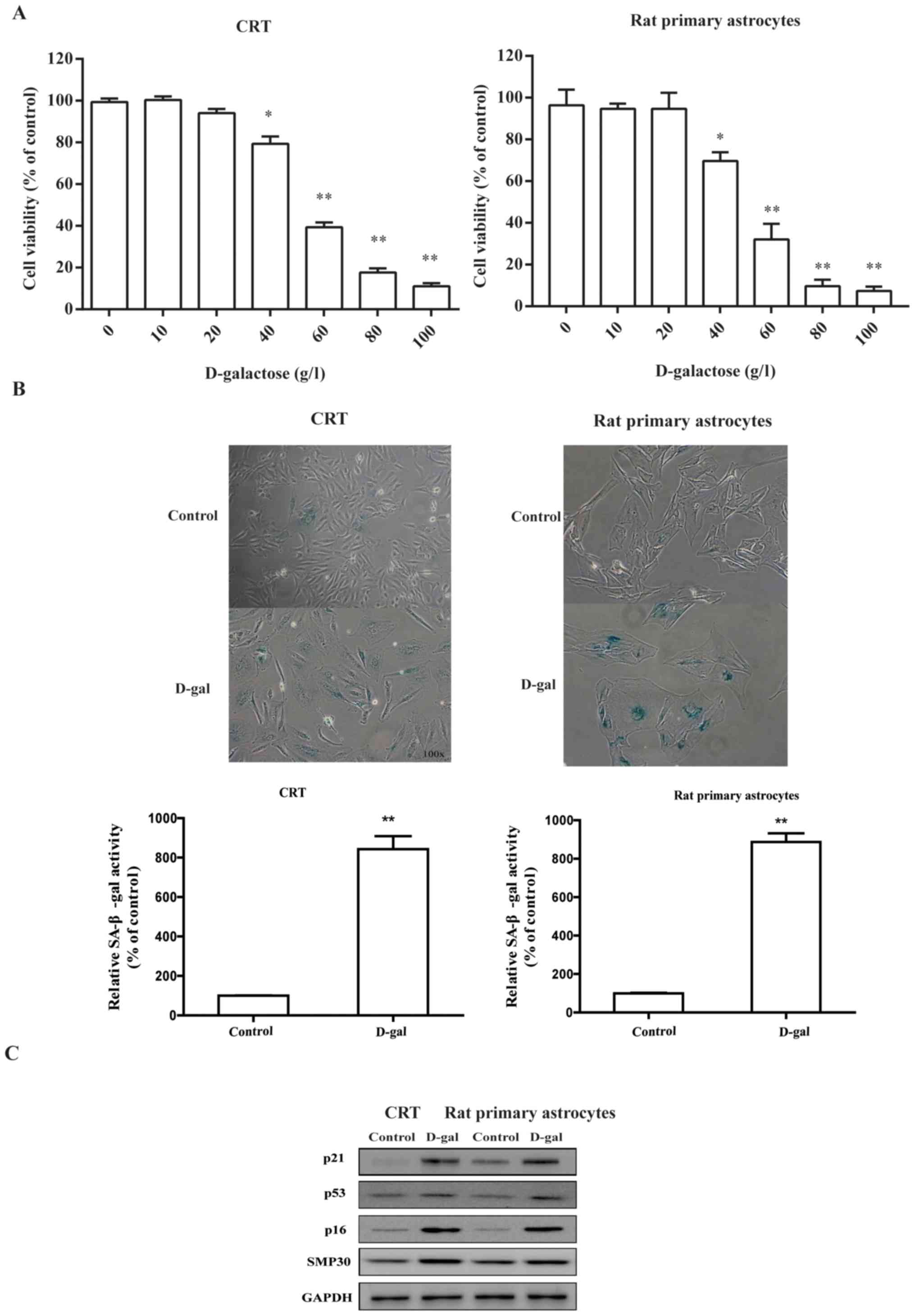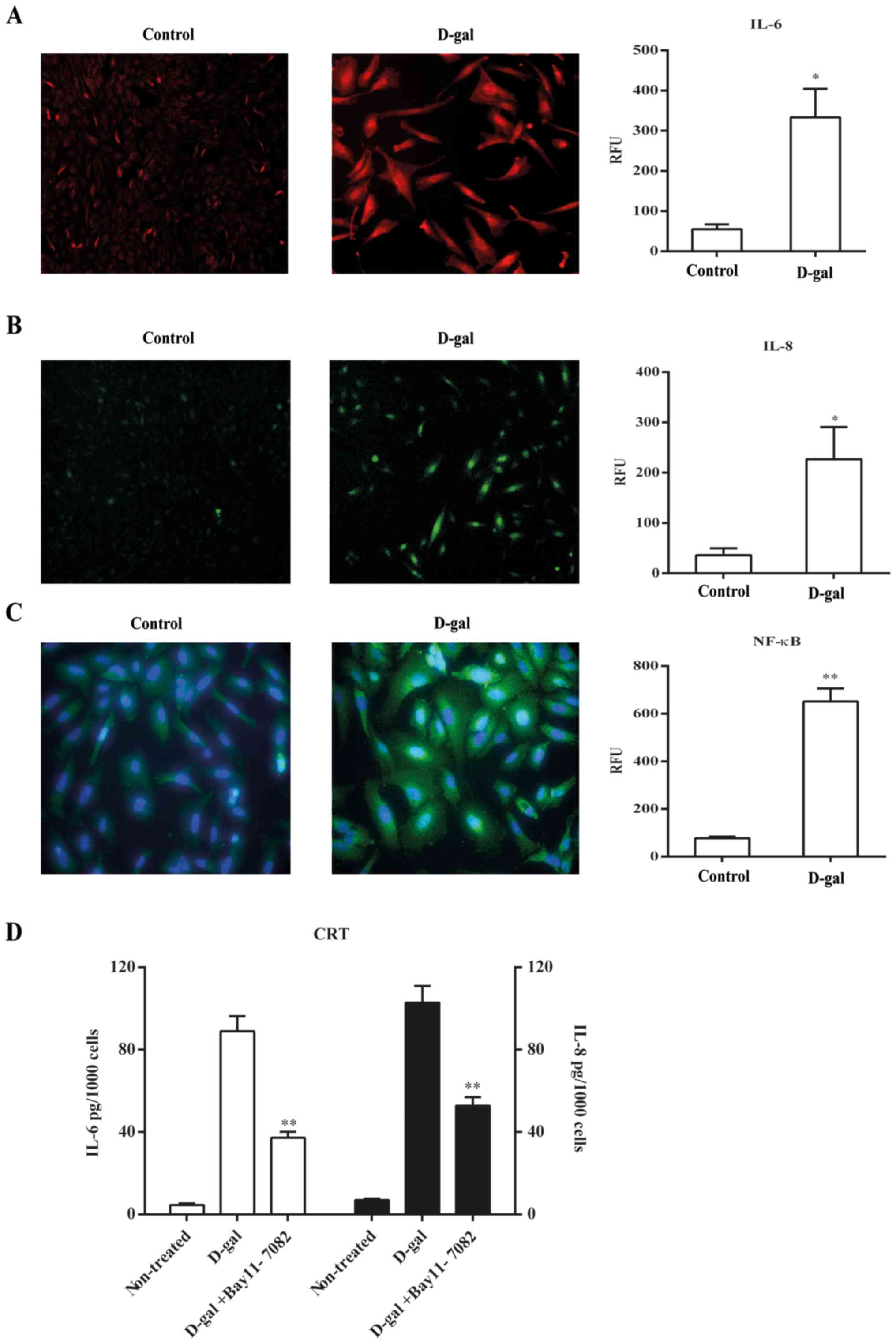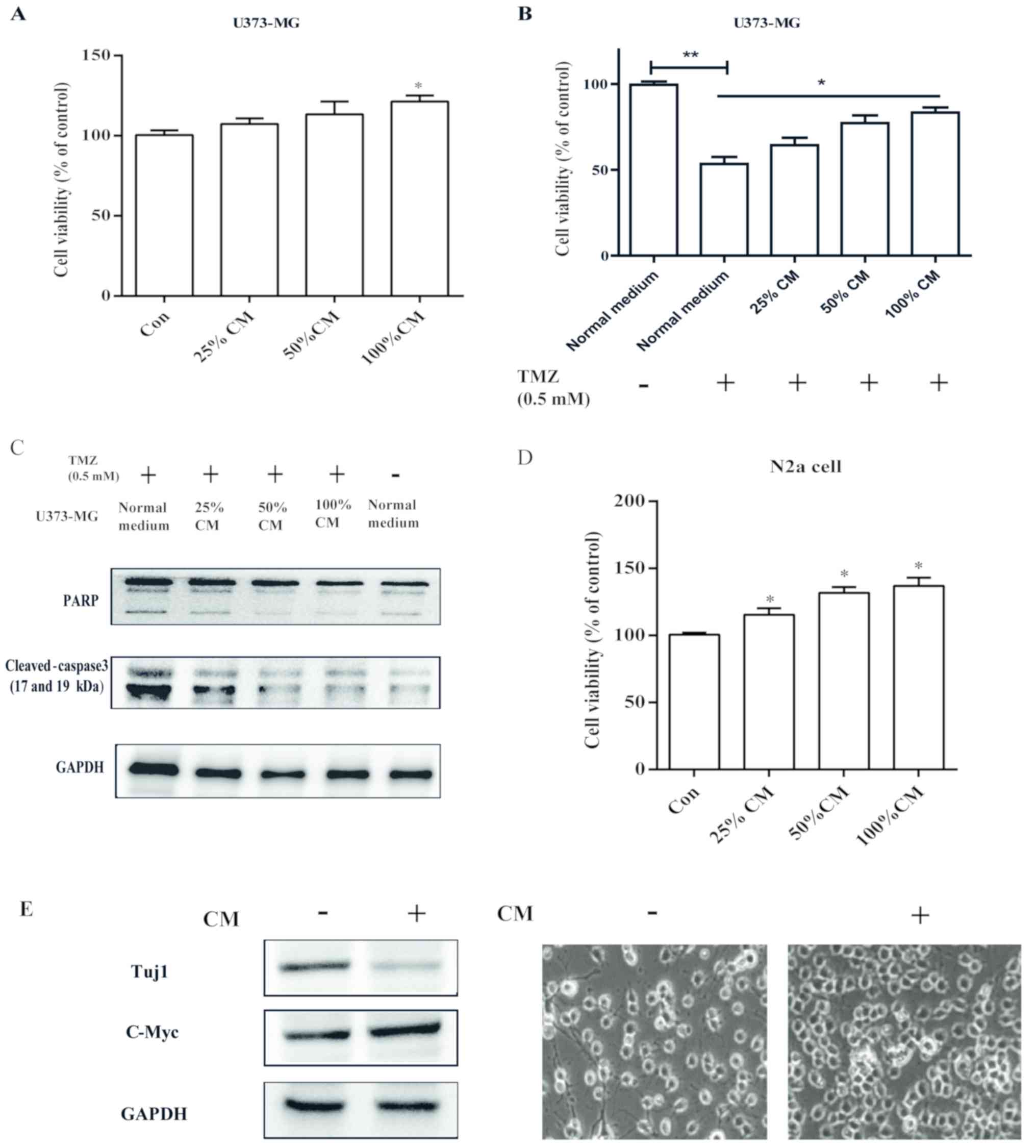|
1
|
Allsopp RC and Harley CB: Evidence for a
critical telomere length in senescent human fibroblasts. Exp Cell
Res. 219:130–136. 1995. View Article : Google Scholar : PubMed/NCBI
|
|
2
|
Ito T, Teo YV, Evans SA, Neretti N and
Sedivy JM: Regulation of cellular senescence by polycomb chromatin
modifiers through distinct DNA damage-and histone
methylation-dependent pathways. Cell Rep. 22:3480–3492. 2018.
View Article : Google Scholar : PubMed/NCBI
|
|
3
|
Robinson AR, Yousefzadeh MJ, Rozgaja TA,
Wang J, Li X, Tilstra JS, Feldman CH, Gregg SQ, Johnson CH, Skoda
EM, et al: Spontaneous DNA damage to the nuclear genome promotes
senescence, redox imbalance and aging. Redox Biol. 17:259–273.
2018. View Article : Google Scholar : PubMed/NCBI
|
|
4
|
Wang W, Li P, Xu J, Wu X, Guo Z, Fan L,
Song R, Wang J, Wei L and Teng H: Resveratrol attenuates high
glucose-induced nucleus pulposus cell apoptosis and senescence
through activating the ROS-mediated PI3K/Akt pathway. Biosci Rep.
38:BSR201714542018. View Article : Google Scholar : PubMed/NCBI
|
|
5
|
Li T, Shi D, Wu Q, Zhang Z, Qu H and Jiang
Y: Sodium para-aminosalicylate delays pericarp browning of litchi
fruit by inhibiting ROS-mediated senescence during postharvest
storage. Food Chem. 278:552–559. 2019. View Article : Google Scholar : PubMed/NCBI
|
|
6
|
Myrianthopoulos V, Evangelou K, Vasileiou
PVS, Cooks T, Vassilakopoulos TP, Pangalis GA, Kouloukoussa M,
Kittas C, Georgakilas AG and Gorgoulis VG: Senescence and
senotherapeutics: A new field in cancer therapy. Pharmacol Ther.
193:31–49. 2019. View Article : Google Scholar : PubMed/NCBI
|
|
7
|
Sieben CJ, Sturmlechner I, van de Sluis B
and van Deursen JM: Two-step senescence-focused cancer therapies.
Trends Cell Biol. 28:723–737. 2018. View Article : Google Scholar : PubMed/NCBI
|
|
8
|
Ovadya Y, Landsberger T, Leins H, Vadai E,
Gal H, Biran A, Yosef R, Sagiv A, Agrawal A, Shapira A, et al:
Impaired immune surveillance accelerates accumulation of senescent
cells and aging. Nat Commun. 9:54352018. View Article : Google Scholar : PubMed/NCBI
|
|
9
|
Shakeri H, Lemmens K, Gevaert AB, De Meyer
GRY and Segers VF: Cellular senescence links aging and diabetes in
cardiovascular disease. Am J Physiol Heart Circ Physiol.
315:H448–H462. 2018. View Article : Google Scholar : PubMed/NCBI
|
|
10
|
Jeon OH, David N, Campisi J and Elisseeff
JH: Senescent cells and osteoarthritis: A painful connection. J
Clin Investig. 128:1229–1237. 2018. View
Article : Google Scholar : PubMed/NCBI
|
|
11
|
Baar MP, Perdiguero E, Munoz-Canoves P and
de Keizer PL: Musculoskeletal senescence: A moving target ready to
be eliminated. Curr Opin Pharm. 40:147–155. 2018. View Article : Google Scholar
|
|
12
|
Gonzalez-Meljem JM, Apps JR, Fraser HC and
Martinez-Barbera JP: Paracrine roles of cellular senescence in
promoting tumourigenesis. Br J Cancer. 118:1283–1288. 2018.
View Article : Google Scholar : PubMed/NCBI
|
|
13
|
Corlier F, Hafzalla G, Faskowitz J, Kuller
LH, Becker JT, Lopez OL, Thompson PM and Braskie MN: Systemic
inflammation as a predictor of brain aging: Contributions of
physical activity, metabolic risk, and genetic risk. Neuroimage.
172:118–129. 2018. View Article : Google Scholar : PubMed/NCBI
|
|
14
|
Salminen A, Ojala J, Kaarniranta K,
Haapasalo A, Hiltunen M and Soininen H: Astrocytes in the aging
brain express characteristics of senescence-associated secretory
phenotype. Eur J Neurosci. 34:3–11. 2011. View Article : Google Scholar : PubMed/NCBI
|
|
15
|
Lu J, Wu Dm, Zheng Y, Hu B and Zhang Zf:
Purple Sweet Potato Color Alleviates D-galactose-induced brain
aging in old mice by promoting survival of neurons via PI3K pathway
and inhibiting cytochrome c-mediated apoptosis. Brain Pathol.
20:598–612. 2010. View Article : Google Scholar : PubMed/NCBI
|
|
16
|
Cui X, Wang L, Zuo P, Han Z, Fang Z, Li W
and Liu J: D-Galactose-caused life shortening in Drosophila
melanogaster and Musca domestica is associated with oxidative
stress. Biogerontology. 5:317–325. 2004. View Article : Google Scholar : PubMed/NCBI
|
|
17
|
Shwe T, Pratchayasakul W, Chattipakorn N
and Chattipakorn SC: Role of D-galactose-induced brain aging and
its potential used for therapeutic interventions. Exp Gerontol.
101:13–36. 2018. View Article : Google Scholar : PubMed/NCBI
|
|
18
|
Choi C, Xu X, Oh JW, Lee SJ, Gillespie GY,
Park H, Jo H and Benveniste EN: Fas-induced expression of
chemokines in human glioma cells: Involvement of extracellular
signal-regulated kinase 1/2 and p38 mitogen-activated protein
kinase. Cancer Res. 61:3084–3091. 2001.PubMed/NCBI
|
|
19
|
Choi C, Kutsch O, Park J, Zhou T, Seol DW
and Benveniste EN: Tumor necrosis factor-related apoptosis-inducing
ligand induces caspase-dependent interleukin-8 expression and
apoptosis in human astroglioma cells. Mol Cell Biol. 22:724–736.
2002. View Article : Google Scholar : PubMed/NCBI
|
|
20
|
Bhat R, Crowe EP, Bitto A, Moh M, Katsetos
CD, Garcia FU, Johnson FB, Trojanowski JQ, Sell C and Torres C:
Astrocyte senescence as a component of alzheimer's disease. PLoS
One. 7:e450692012. View Article : Google Scholar : PubMed/NCBI
|
|
21
|
Akinyeke T, Matsumura S, Wang X, Wu Y,
Schalfer ED, Saxena A, Yan W, Logan SK and Li X: Metformin targets
c-MYC oncogene to prevent prostate cancer. Carcinogenesis.
34:2823–2832. 2013. View Article : Google Scholar : PubMed/NCBI
|
|
22
|
Coppe JP, Desprez PY, Krtolica A and
Campisi J: The senescence-associated secretory phenotype: The dark
side of tumor suppression. Annu Rev Pathol. 5:99–118. 2010.
View Article : Google Scholar : PubMed/NCBI
|
|
23
|
Orjalo AV, Bhaumik D, Gengler BK, Scott GK
and Campisi J: Cell surface-bound IL-1alpha is an upstream
regulator of the senescence-associated IL-6/IL-8 cytokine network.
Proc Natl Acad Sci USA. 106:17031–17036. 2009. View Article : Google Scholar : PubMed/NCBI
|
|
24
|
Davalos AR, Coppe JP, Campisi J and
Desprez PY: Senescent cells as a source of inflammatory factors for
tumor progression. Cancer Metastasis Rev. 29:273–283. 2010.
View Article : Google Scholar : PubMed/NCBI
|
|
25
|
Le Duff M, Gouju J, Jonchère B, Guillon J,
Toutain B, Boissard A, Henry C, Guette C, Lelièvre E and Coqueret
O: Regulation of senescence escape by the cdk4-EZH2-AP2M1 pathway
in response to chemotherapy. Cell Death Dis. 9:1992018. View Article : Google Scholar : PubMed/NCBI
|
|
26
|
Cui X, Zuo P, Zhang Q, Li X, Hu Y, Long J,
Packer L and Liu J: Chronic systemic D-galactose exposure induces
memory loss, neurodegeneration, and oxidative damage in mice:
Protective effects of R-alpha-lipoic acid. J Neurosci Res.
84:647–654. 2006. View Article : Google Scholar : PubMed/NCBI
|
|
27
|
Lu J, Zheng YL, Wu DM, Luo L, Sun DX and
Shan Q: Ursolic acid ameliorates cognition deficits and attenuates
oxidative damage in the brain of senescent mice induced by
D-galactose. Biochem Pharmacol. 74:1078–1090. 2007. View Article : Google Scholar : PubMed/NCBI
|
|
28
|
Liu R, Zhang TT, Zhou D, Bai XY, Zhou WL,
Huang C, Song JK, Meng FR, Wu CX, Li L and Du GH: Quercetin
protects against the Aβ(25–35)-induced amnesic injury: Involvement
of inactivation of rage-mediated pathway and conservation of the
NVU. Neuropharmacology. 67:419–431. 2013. View Article : Google Scholar : PubMed/NCBI
|
|
29
|
Xing Z, He Z, Wang S, Yan Y, Zhu H, Gao Y,
Zhao Y and Zhang L: Ameliorative effects and possible molecular
mechanisms of action of fibrauretine from Fibraurea recisa Pierre
on d-galactose/AlCl3-mediated Alzheimer's disease. RSC
Advances. 8:31646–31657. 2018. View Article : Google Scholar
|
|
30
|
Kumar A, Prakash A and Dogra S: Naringin
alleviates cognitive impairment, mitochondrial dysfunction and
oxidative stress induced by D-galactose in mice. Food Chem Toxicol.
48:626–632. 2010. View Article : Google Scholar : PubMed/NCBI
|
|
31
|
Zhang XL, An LJ, Bao YM, Wang JY and Jiang
B: D-galactose administration induces memory loss and energy
metabolism disturbance in mice: Protective effects of catalpol.
Food Chem Toxicol. 46:2888–2894. 2008. View Article : Google Scholar : PubMed/NCBI
|
|
32
|
Ali T, Badshah H, Kim TH and Kim MO:
Melatonin attenuates D-galactose-induced memory impairment,
neuroinflammation and neurodegeneration via RAGE/NF-κB/JNK
signaling pathway in aging mouse model. J Pineal Res. 58:71–85.
2015. View Article : Google Scholar : PubMed/NCBI
|
|
33
|
Parrinello S, Coppe JP, Krtolica A and
Campisi J: Stromal-epithelial interactions in aging and cancer:
Senescent fibroblasts alter epithelial cell differentiation. J Cell
Sci. 118:485–496. 2005. View Article : Google Scholar : PubMed/NCBI
|
|
34
|
Laberge RM, Awad P, Campisi J and Desprez
PY: Epithelial-mesenchymal transition induced by senescent
fibroblasts. Cancer Microenviron. 5:39–44. 2012. View Article : Google Scholar : PubMed/NCBI
|












